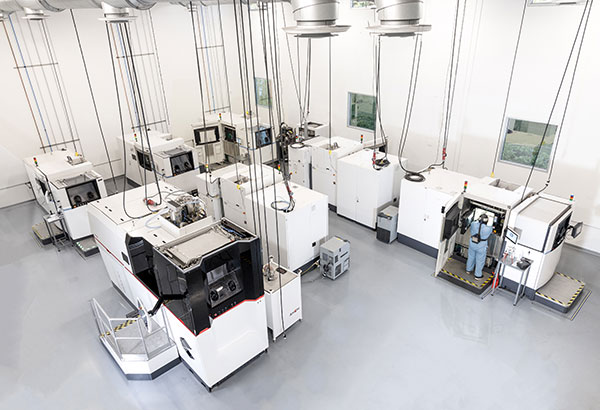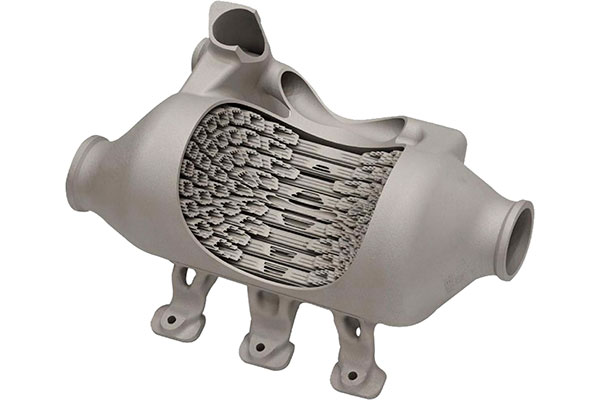Case Study: Sintavia Extends Vertical Integration Strategy to Software
The digital manufacturer of metal aerospace parts leverages Siemens’ end-to-end suite to fuel simulation-based design through AM production at scale.

Sintavia uses printer simulation software from printer provider EOS to augment its simulation regime and refine heat exchanger designs. Image courtesy of Sintavia.
Latest News
March 28, 2024
When you’re designing and producing complex mechanical metal components for the highly regulated aerospace industry, leave nothing to chance.
That’s why Sintavia, founded in 2015 as a pure play digital manufacturer, decided right from the start to take flight with a vertically integrated business model. The firm made major investments in the full complement of equipment and capabilities required to build and design aerospace parts, including laboratories, 3D printer fleets, furnaces, post-processing gear, accreditation processes and even quality management systems.
Sintavia upheld that same vertical alignment strategy with its core application stack, and opted to standardize on Siemens Digital Industries Software’s design and manufacturing suite to have end-to-end capabilities and holistic visibility from a single, integrated offering.
Maintaining critical hardware and software capabilities under one roof is central to Sintavia’s mission as it charts a new digital manufacturing course. The company’s clients include Lockheed Martin, Northrop Grumman, the U.S. Navy and Honeywell Aerospace.
“It’s important for us to have all of the capabilities in house because what we’re doing with digital manufacturing is such a new concept, especially in the aerospace and defense sector,” says Brian Neff, CEO at Sintavia. “The vertical integration of hardware and software is really important when dealing with new technology. Once it matures, it becomes more like a supply chain discussion, but we’re not there yet.”
Sintavia’s decision to compete as a pure play digital manufacturer gives it an edge among competitors in the sector as most are experimenting with additive manufacturing (AM) or using the technology in pockets without a wholesale commitment.
“Our competitors all have a digital thread that goes from design through the certification process, but they’re not really committed to it,” Neff says. “They don’t want to cannibalize their revenue stream by adopting an all-digital approach. For us, as disruptors, it was important to dive head first into the world of digital design and manufacturing.”
Balkanization of Software a Challenge
When Sintavia launched in 2015 with a charter to design and 3D print advanced propulsion and thermodynamic systems, a robust, end-to-end design-to-manufacturing software platform wasn’t readily available. Early engineering efforts at Sintavia were orchestrated, juggling a mix of offerings from leading vendors in the space, including Ansys, Materialise, SolidWorks and Mastercam, Neff says. The individual applications were highly capable, but creating an integrated workflow required lots of importing and exporting of data and files between the different modules—a laborious process that introduced human error and didn’t set up well for identifying flaws that could easily be addressed in iterative designs.
“The balkanized software suites were working okay for us, but the file transfers were bulky and single directional,” Neff explains. The lack of a closed-loop workflow was also problematic. “God forbid there was a problem in step five—there was no way to go back and adjust the actual design.”

Siemens’ effort to create a vertically integrated design-to-manufacturing software platform appeared on Sintavia’s radar screen, and the company soon embarked on a partnership to help advance development of that portfolio. Sintavia agreed to provide testing and technical feedback on prerelease versions of Siemens’ end-to-end AM solution, which was part of the broader Xcelerator portfolio. Sintavia also received Siemens technical support during the collaboration.
AM-made heat exchangers are the heart of Sintavia’s product portfolio. The complex part needs to accommodate a hot fluid flowing next to a cold fluid in a very tightly compressed boundary condition—a design challenge that calls for simulation done early and repeatedly throughout the entire development process. Sintavia accomplishes that through use of Simcenter STAR-CCM+ CFD software, which allows the engineering team to feed customer parameters into the software to simulate how fluid would work in a given system to come up with the optimal design.
Printer simulation software from EOS, one of the key 3D printers used in Sintavia’s digital manufacturing workflows, rounds out the simulation regime and helps refine heat exchanger designs. The empirical data from the print jobs is integrated with Simcenter STAR-CCM+ simulation data to ensure the final designs are reproducible via AM in an optimized fashion, Neff says.
“We take data from the print jobs, including the areas that are problematic, and pull that back into the simulation-led design to adjust variables,” Neff explains. “We are able to produce heat exchangers that are highly complex and tight as a drum because we are killing ourselves on simulation.”
Teamcenter, Opcenter Round Out Platform
Once fully operational with the NX suite, Sintavia added the Teamcenter Enterprise PLM platform and Opcenter unified manufacturing operations management solution to the mix. Teamcenter helped lock down data and processes, which is critical to manufacturing products in a highly regulated industry like aerospace & defense.
Opcenter was an important addition as Sintavia’s engineering group and client workload began to scale and especially to help manage the complexity of the AM process, which encompasses everything from casting to metallurgical sampling to inspection and traceability. The synergies between both platforms enable Sintavia to create manufacturing processes, which are then executed on the shop floor.
Prior to Teamcenter and Opcenter, Sintavia used a decentralized Excel spreadsheet to track everything, which was less than ideal.
“The main benefit Opcenter brings us is structure and ease of information—everything is centralized in one location so anyone can look at data at any time they want,” says Jeremy Wong, Sintavia’s lead digital manufacturing engineer. “Opcenter and Teamcenter snapping together makes working with software systems a lot easier.”
Wong says the pair function as a control center, allowing the team to manage the health and state of individual projects throughout the facility while also providing visibility into whether projects are on time and raising red flags when they are not, he says.
Given the complexity of AM practices, it’s important for all workers to be up to speed, and Teamcenter serves as a centralized knowledge center for new employees, Neff adds. “If we have a top-notch engineer that’s new to AM and what we do, all we have to do is teach them Teamcenter and how to find relevant information—not teach them AM processes or design work,” Neff says.
Of course, you can’t just flip a switch and mandate new technology and workflows. Therefore, managing culture change is a big part of successfully implementing an end-to-end software platform.
“You need to have patience and perseverance,” says Neff. “If you have people in the organization who are resistant to that change, help them embrace it and if they don’t, they eventually have to move on. Once an organization culturally embraces something like this, that’s when you get momentum.”
While Sintavia doesn’t have a baseline to establish a “before picture,” Neff says the vertically integrated software strategy is helping the company move the needle on margin improvements as well as minimizing mistakes and reprints of production orders.
“From an economic standpoint, we’re seeing much better first-time-right printing as a result of the changes,” Neff says.
Subscribe to our FREE magazine, FREE email newsletters or both!
Latest News
About the Author
Beth Stackpole is a contributing editor to Digital Engineering. Send e-mail about this article to [email protected].
Follow DE





